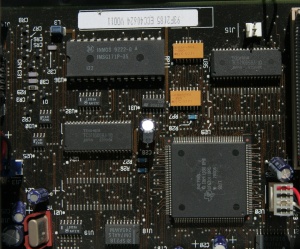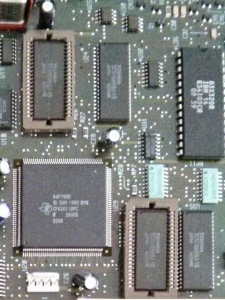Year of introduction: 1991
Data for the U.S. models:
| Models | C42 | B82 | C92 | G42 |
| CPU | 386SX/16 | 386SX/16 | 386SX/16 | 386SX/20 |
| Bays (total/avail.) |
2/0 | 3/1 | 2/0 | 2/0 |
| Hard Drive | 40 MB | 80 MB | 129 MB | 40 MB |
| RAM | 2 MB | 2 MB | 2 MB | 2 MB |
| Expansion Slots | 0 | 2 | 0 | 0 |
| Preloaded Software | IBM DOS 4.01 in ROM Microsoft Works 2.0A Prodigy Promenade Tutorial |
IBM DOS 4.01 in ROM Microsoft Windows 3.0 Microsoft Works 2.0 Microsoft Productivity Pack Prodigy Promenade Tutorial |
IBM DOS 4.01 in ROM Microsoft Windows 3.0 Microsoft Works 2.0A Productivity Pack for Windows Prodigy Promenade Tutorial |
IBM DOS 4.01 Microsoft Works 2.0A Prodigy Promenade Tutorial |
| Models | A82 | S92 | A62 | M82 | A94 |
| CPU | 386SX/20 | 386SX/20 | 386SX/20 | 386SX/20 | 386SX/20 |
| Bays (total/avail.) |
3/1 | 2/0 | 3/1 | 3/1 | 3/1 |
| Hard Drive | 80 MB | 129 MB | 160 MB | 80 MB | 129 MB |
| RAM | 2 MB | 2 MB | 2 MB | 2 MB | 6 MB |
| Expansion Slots | 2 | 0 | 2 | 2 | 2 |
| Preloaded Software | IBM DOS 4.01 Microsoft Windows 3.0 Microsoft Works 2.0A Productivity Pack for Windows Prodigy Promenade Tutorial |
IBM DOS 4.01 Microsoft Windows 3.0 Microsoft Works 2.0A Productivity Pack for Windows Prodigy Promenade Tutorial |
IBM DOS 4.01 Microsoft Windows 3.0 Microsoft Works 2.0A Productivity Pack for Windows Prodigy Promenade Tutorial |
IBM DOS 4.01 Microsoft Windows 3.0 Microsoft Works 2.0A Productivity Pack for Windows Quicken 5.0 Prodigy Promenade Tutorial |
IBM OS/2 2.0 Tutorial |
| Bus Type | ISA Bus |
| Memory Maximum | 6 MB |
| Floppy Drive | 3.5″ 1.44MB |
| HDD Controller | IDE Controller |
| Video Memory | 256KB VGA (256KB Maximum) |
| Power Supply | 65 Watt Power Supply, In Monitor |
| Parallel Ports | PS/2 Bi-Directional |
| Serial Ports | None (A92 has one) |
| Modem | 2400 bps Hayes Compatible |
| Keyboard | IBM 101-Key Keyboard |
| Mouse | IBM Mouse, PS/2 Style Connection |
All of these machines use a standard IDE controller. This interface should support any standard IDE device. Some Enhanced IDE (EIDE) devices (namely hard drives larger than 528MB) may be able to function with the use of disk overlay software, normally supplied by the drive manufacturer, but this is not supported by IBM.
PS/1s are not truly “AT compatible” in terms of CMOS hard disk definitions and interrupt vectors. So in order to boot Unix/Linux and Windows NT you need a compatibility COM file called UNIXBOOT.EXE. You can find it under the Downloads section.
Any ISA card (CD-ROM controller, modem, SCSI card) added to these machines needs to be non-“Plug and Play” to help insure compatability.
(S)VGA
According to IBM Corp., the PS/1 – 2121 has a standard VGA with 256KB of memory, very much like the 2011’s one.
Actually the chip used was the IBM 84F7985 / TI CF62011BPC. Unfortunately there’s no datasheet and information is very scarce (if you have any technical details please let me know.)
U20: IBM 84F7985 / TI CF62011BPC
U36: INMOS IMSG171P-35, 35MHz color LUT
U24: Toshiba TC511665BJ-10, 100ns 65K x 16-bit (128KB) CMOS DRAM
U35: Toshiba TC511665BJ-10, 100ns 65K x 16-bit (128KB) CMOS DRAM
U21: unpopulated DRAM solder pads
U29: unpopulated DRAM solder pads
The TI CF62011BPC is a SVGA chip and it could use up to 1MB of memory, but on the PS/1 2121 was configured with only 256KB, limiting it to the standard VGA modes.
It was also used on other IBM Personal System machines of the same era, for example the PS/2 Model 25SX. This means that VESA DOS support can be obtained using the same TSR driver: VESA.EXE
Depending on the amount of VRAM installed, this driver adds support for these additional video modes:
- 640×400 256-color graphics
- 640×480 256-color graphics
- 132-column x 25-row text
According to www.walshcomptech.com it’s the same adapter as the IBM SVGA Adapter/A (MCA ID 090EEh), with the most notable differences being faster VRAM and RAMDAC. The VESA DOS graphics driver for that card can reportedly be used: m95svga.exe
It responds at ports in the range 0x2100-0x210F, which are the same as the XGA.
No drivers for Windows are known to exist, but OS/2 seems to have a driver for it.
The VRAM can be expanded to 512KB by soldering two 65Kx16 DRAM chips in U21 and U29. This will enable the 640x480x256 video mode using the VESA driver for the PS/2 25SX.

